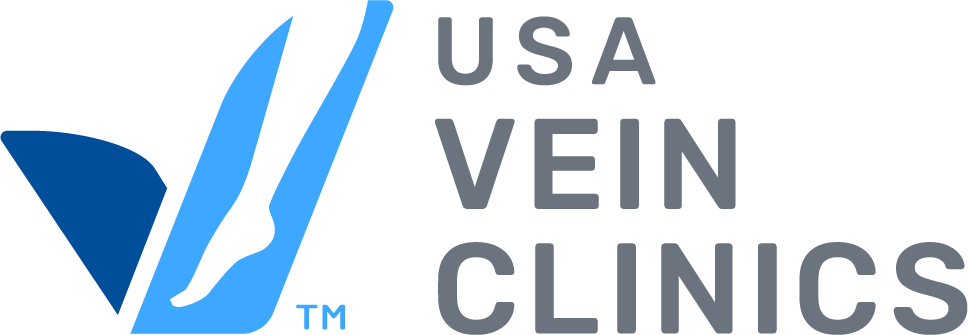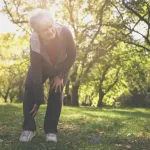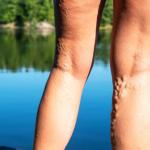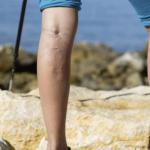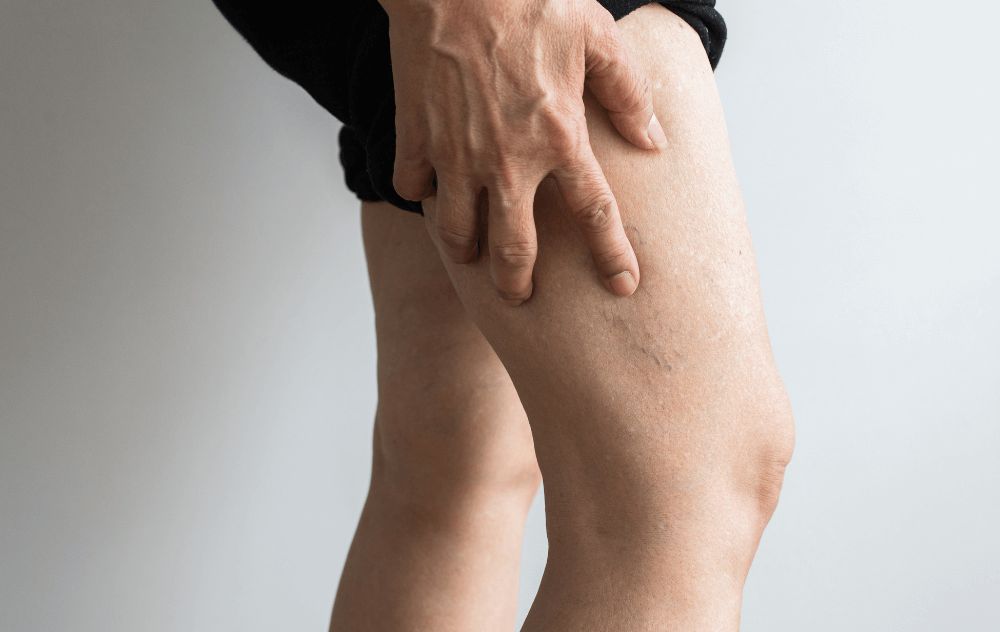
If you suffer from swollen, heavy, aching legs due to varicose veins, we may be able to help. At USA Vein Clinics, our vein specialists offer sclerotherapy vein treatment to treat painful symptoms of vein disease. Sclerotherapy is a minimally invasive, non-surgical, office-based vein treatment for varicose and spider veins. Not only can it improve the appearance of visible veins, but it can also treat associated pain and discomfort.
Varicose veins and spider veins indicate underlying vein disease, also known as venous insufficiency. To effectively circulate blood throughout the body, your veins need to pump blood back to the heart against gravity. Vein disease develops when vein valves are chronically strained and begin to malfunction. Most commonly, veins in the legs, ankles, and feet are impacted.
Unfortunately, damaged vein valves make it challenging for veins to do their job. This can cause blood to pool in the lower extremities which, in turn, can lead to varicose and spider veins, along with a range of other symptoms. Over time, symptoms can become severe and impact quality of life.
Common symptoms of vein disease include:
- Leg pain that improves when you walk or raise your legs
- Itchy, dry skin
- Numbness or tingling sensation
- Swelling in the legs and ankles
- Tired, aching legs
- Burning in the calf or thigh
- Difficulty standing for long periods
- Non-healing wounds on your legs
If these issues sound like ones you’d prefer to avoid, we certainly understand the sentiment. You may also wonder who is most at risk for developing vein disease. For most individuals, there are multiple contributing factors involved. Lifestyle and genetic factors play a part. Unfortunately, even if you follow a healthy lifestyle, you may not be able to avoid vein disease.
Risk factors for vein disease include:
- Genetics: If you have close relatives with varicose veins and other vein symptoms, you are at increased risk. Your risk further increases if you have multiple close relatives with poor vein health.
- Being obese or overweight: Carrying around extra pounds can strain your veins and sometimes cause irreversible damage. To improve your vein health, losing excess weight may be a top priority. We suggest focusing on maintaining a healthy body mass index (BMI) through eating a healthy diet and exercising regularly. If you need additional support to reach your weight loss goals, talk to your doctor.
- Inactivity: While physical movement promotes good blood circulation, inactive behavior like sitting on your couch watching TV doesn’t. Fortunately, nearly all forms of physical exercise are beneficial when it comes to managing your vein health. Many people find that going for daily walks is an easy, enjoyable, and inexpensive way to get moving. You may want to recruit a friend or family member to join you.
- Age: As you get older, you are more likely to develop varicose veins. Although anyone can develop vein problems at any age, your risk increases beyond age 50.
- Sex: Women are more likely to experience varicose veins. This may be related to pregnancy.
- Pregnancy: When you are pregnant, your blood volume increases and places additional strain on your veins. An influx of pregnancy hormones may also influence the development of varicose veins.
- Other underlying health conditions: Unfortunately, high blood pressure, diabetes, and other health issues can put you at greater risk for venous insufficiency. These conditions can also cause your symptoms to worsen over time.
- Prolonged periods of standing or sitting: If you spend your days standing in one place or sitting still, your vein health may be compromised. To avoid developing future issues, take frequent breaks throughout the day to walk around and stretch. You can also do exercises in place, such as ankle rolls and calf raises, to get your blood flowing. Additionally, massaging your legs, ankles, and feet may be beneficial. Propping up your feet at the end of the day can help relieve painful symptoms.
If you are at risk for vein disease, founder and CEO Dr. Yan Katsnelson wants to assure you that there’s help available. “All of our vein specialists at USA Vein Clinics offer a range of potential treatments for varicose and spider veins. We also treat more serious venous conditions like venous ulcers and can help identify blood clots, which can lead to a life-threatening condition known as pulmonary embolism,” he explains.
Currently, we offer the following vein treatments:
- Endovenous Laser Treatment (EVLT)
- ClariVein
- Varithena Foam
- VenaSeal™ Closure System Treatment
- Sclerotherapy
Our vein specialists will work with you every step of the way to develop an individualized plan of care. Some patients may require multiple sessions or more than one type of treatment.
If sclerotherapy vein treatment is recommended for you, below we provide helpful information about this minimally invasive, outpatient procedure. We cover: what is sclerotherapy?, sclerotherapy before and after, how to prepare for sclerotherapy, and why you may want to choose USA Vein Clinics to perform your sclerotherapy treatment.
If you have additional questions about sclerotherapy vein treatment, we suggest consulting a vein specialist.
What Is Sclerotherapy?
Sclerotherapy vein treatment is a minimally invasive, office-based technique that treats spider veins and small varicose veins. It has been around for over a century, and can be used for cosmetic reasons or for symptomatic relief. The treatment typically takes less than an hour, from start to finish. Sclerotherapy can be used on most regions of the body, including the legs, ankles, feet, and face.
Sclerotherapy is performed by one of our highly skilled interventional radiologists. The technique involves the injection of sclerosant agents into malfunctioning veins. Sclerosant agents are substances that intentionally irritate the veins and cause scarring. Sclerosants also cause veins to collapse and close off circulation to targeted areas. Your blood flow is then diverted to healthy, surrounding veins.
Sclerotherapy does not generally require anesthesia and is not usually considered painful. However, you may experience some minor sensations of stinging or cramping during the procedure.
There are two types of sclerotherapy treatment: Visual and Ultrasound-Guided. Which one is used depends on how deep your damaged veins are located. Both methods are usually performed as you lie on your back with legs elevated. Your doctor will first cleanse the area with alcohol, then numb it, if necessary. At USA Vein Clinics, we always use the smallest needle possible for your comfort.
Visual Sclerotherapy for spider veins is the treatment of choice for tiny, visible, web-patterned spider veins located near the skin’s surface. Your vein specialist will use a small needle to inject a sclerosant agent into affected veins. This substance causes diseased veins to close off and collapse, diverting blood flow to healthy ones. Over time, the treated veins are reabsorbed by the body. There is no need for surgical removal.
Ultrasound-Guided Sclerotherapy works similarly and can be used to treat spider veins or small varicose veins, also located relatively near the skin’s surface. This variation uses real-time, precision ultrasound imaging to guide the needle into deeper veins. These veins may be more difficult to find than those treated with visual sclerotherapy. As with visual sclerotherapy, an ultrasound-guided sclerotherapy injection irritates the impacted vessel and prompts it to collapse and close off.
In the coming days or weeks, your venous symptoms should reduce or resolve. The outer appearance of treated veins should also improve.
At USA Vein Clinics, your vein specialist will work with you to determine which treatment method is best for you. This might be sclerotherapy, Endovenous Laser Therapy (EVLT), ClariVein, or Varithena Foam Treatment. Sometimes, a combination of treatments are recommended.
Vein treatment is not usually recommended for women who are pregnant or breastfeeding. “If you have recently given birth, you may wish to talk to one of our specialists about appropriate timing for vein treatment. We can work with you to develop a personalized treatment plan,” says Dr. Yan Katsnelson.
How to Prepare for Sclerotherapy Treatment
If you are interested in pursuing sclerotherapy treatment, you may be wondering what to expect before your procedure. For instance, we are often asked: How long does it take for sclerotherapy to heal? Another common question we get before sclerotherapy: how long does it take to work? Before scheduling treatment, you will have the opportunity to meet with one of our highly experienced, compassionate vein specialists. This is the perfect time to bring up any questions or concerns.
During your appointment, we will discuss your medical history and any current medications you are taking (including supplements). Be sure to mention any previous vein treatments. To avoid potential complications, you may need to stop taking certain medications several days before treatment. Additionally, please avoid using lotion on your legs (or other treatment regions) before and after your procedure.
Your vein specialist may perform an ultrasound of your veins during your initial consultation. This is a type of live medical imaging that gathers additional information and helps confirm that sclerotherapy treatment is the best course of action. Rest assured that you are in experienced hands when you choose to visit one of our vein specialists.
We suggest wearing loose, comfortable clothing to the clinic. Some patients prefer to wear shorts to easily expose their legs. You may want to consider bringing a companion for support on your treatment day. Your friend or family member may be required to wait outside or in the car. Most patients can drive themselves home.
Sclerotherapy Recovery
After sclerotherapy treatment, it’s time to move forward with your life. You are probably wondering, how long does it take to heal from sclerotherapy? The good news is that after your procedure, you can leave immediately and return to most normal activities. Little to no downtime is required.
The full length and extent of recovery can vary. For some patients, symptomatic relief is immediate. Others can expect improvement within a few days to a few weeks. Larger veins may take up to several months and require additional injections. Follow-up injections, when recommended, usually occur about one month apart.
We want you to be aware that, as with other medical procedures, side effects are possible. You should also expect that, initially, your veins may look worse. This is rarely a cause for concern, and their appearance will improve during recovery.
Common sclerotherapy side effects include:
- Bruising
- Stinging
- Swelling
- Skin discoloration
- Discomfort
- Raised red areas of skin
- Brown lines on the skin
If you experience any post-procedure discomfort, please contact your doctor. For pain relief, your vein specialist may recommend that you take an over-the-counter pain reliever like Ibuprofen.
Although serious health risks are rare, they can occur and may include:
- Allergic reaction
- Skin ulceration
- Formation of blood clots
- Infection
- Excessive bleeding
If you suspect one or more of these potentially dangerous conditions, seek medical care immediately.
One serious possibility, the development of deep vein thrombosis (DVT), is considered a medical emergency. DVT places you at risk for a pulmonary embolism, which can be life-threatening. Keep an eye out for DVT symptoms, which include pain, swelling, warmth, cramping, and discoloration. These usually occur only on one side of the body. If you notice any potential signs, please head to an emergency room right away.
You can resume most normal activities after vein treatment. However, there are a few exceptions.
After sclerotherapy, you should avoid:
- Inactivity
- Strenuous exercise
- Heavy lifting
- Sun
- Hot baths
- Swimming pools
- The beach
These limitations will probably be in place for several days to several weeks. During this time, we recommend going out for short, frequent walks throughout the day. You can even begin this walking routine on the same day as your treatment.
Finally, you should know that your doctor will likely recommend the temporary use of compression socks. For the first 24 hours, most individuals are asked to wear these important garments around the clock. After that, you can take them off at night. The length of time compression should be used can vary between patients. Your doctor will base their recommendation on the size, number, and location of your affected veins, along with other factors.
Sclerotherapy Before and After
Now that you are familiar with Sclerotherapy, we want to give you a sense of how it can improve your life. Below is a snapshot of life before and after sclerotherapy treatment.
Life before sclerotherapy might involve significant pain and discomfort that limits your daily activities. In fact, your poor vein health can have a profound impact on your career, relationships, social life, and self-esteem.
Life after sclerotherapy treatment, on the other hand, should look much different and much improved. First of all, you will probably experience significant improvement, and possibly elimination, of your vein symptoms. Plus, you will likely notice a cosmetic improvement. If you’ve been hiding your varicose or spider veins under long pants, you can finally consider wearing shorts or skirts. Most importantly, we believe that you will be able to enjoy a better quality of life without the pain and discomfort of diseased veins.
After sclerotherapy, you can also rest assured that your risk for developing serious health issues like venous ulcers, blood clots, and pulmonary embolism will be reduced.
We do want to mention one last thing. While sclerotherapy is often effective, keep in mind that there is no guarantee it will permanently resolve your vein issues. If you do notice more varicose or spider veins in the future, our experts can offer additional treatment options.
To help reduce your future risk, we suggest that you:
- Maintain a healthy BMI
- Eat a well-rounded diet featuring fruits and vegetables, lean proteins, whole grains, low-fat dairy, and healthy fats
- Limit sodium, added sugars, alcohol, and caffeine
- Exercise regularly
- When standing or sitting for prolonged periods, remember to walk around, stretch out, and massage your legs, ankles, and feet
- Manage health conditions like high blood pressure and diabetes
- Elevate your legs at the end of each day for at least 15 minutes
- Consider regular use of compression socks
- Follow up regularly with your vein specialist
Early intervention is usually the key to the best health outcomes. We encourage you to return to one of our clinics as soon as possible at the first signs of trouble.
Sclerotherapy Treatment at USA Vein Clinics
If you are suffering from vein disease, our experts can help. We are readily available to assess your overall vein health and recommend treatment, if necessary. If you don’t have vein disease but are considered at risk, we can closely monitor your vein health over time. This will allow us to catch potential issues early and offer the most effective treatment options.
Sclerotherapy, along with other types of vein treatment, is usually covered by health insurance, including Medicare and Medicaid. However, you should be aware that some health insurance plans consider spider vein treatment to be cosmetic and won’t cover it.
You can give us a call at 888.768.3467 to discuss your coverage details. We are happy to work directly with your insurance plan to maximize your benefits, along with offering a number of financial resources that can help you obtain affordable care.
We encourage you to schedule a consultation and discover whether sclerotherapy treatment is right for you. We offer over 90 clinic locations across the country, along with virtual doctor appointments. No matter where you decide to visit us, you’ll find world-class vein treatment specialists. We are proud to offer compassionate care, unparalleled expertise, and state-of-the-art facilities.
Medically Reviewed By
Dr. Yan Katsnelson is the founder and CEO of USA Vein Clinics. He is a highly skilled cardiac surgeon who completed a fellowship at the Brigham and Women’s Hospital, Harvard School of Medicine, in Boston, MA. His clinical area of expertise includes minimally invasive procedures to treat vein and vascular diseases. Dr. Katsnelson has established himself as a strong advocate for accessible, affordable, and compassionate healthcare services.
